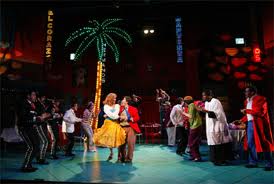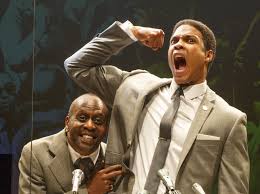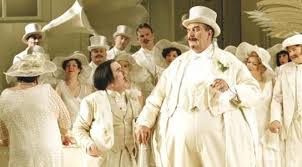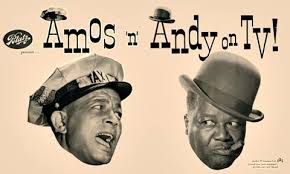If you happen to have been giving any thought to producing Langston Hughes’s 1935 play Mulatto at the Ames Center in Burnsville MN, save yourself some time and either move on to another play or another venue. Why? Because the Ames Center is uncomfortable with the word “mulatto,” and won’t approve it in the title of an offering in their building. Hughes’s stature, and the fact that the Black Repertory Group in Berkeley play produced the show as recently as 2015, probably wouldn’t make any difference.
How do we know this, since the scenario above is hypothetical, in addition to being awfully specific? Because the city-owned Ames Center recently vetoed a production of the play Caucasian-Aggressive Pandas and Other Mulatto Tales, by biracial actor and playwright Derek “Duck” Washington, to be produced by the Ames Center’s resident theatre company, the Chameleon Theatre Circle. The Center cited “mulatto” as the problem, saying they would only allow the play to be done if the word was removed from the title. Caucasian-Aggressive Pandas had already been a hit at the Minnesota Fringe Festival in 2016, after first being produced locally in 2015. That it is Washington’s exploration of his own heritage and his relationship to a relatively archaic racial term, one which is admittedly at its root derogatory in nature, was no defense as far as the Center was concerned. Washington refused to alter the title.
Partly as a result of the dispute over Washington’s play, but with other factors at play as well, Chameleon, a 19-year-old professional non-Equity company which has been a tenant in the Ames Center’s black box theatre since it opened in 2009, will not be renewing their relationship with the venue. Chameleon is currently seeking a new home base in the greater Minneapolis area. The future life for Caucasian Aggressive Pandas is uncertain.
* * *
Multiple dictionary definitions of “mulatto” designate it as both a dated and offensive word, which specifically denotes someone who is the child of one white parent and one black parent. While The Atlantic headlined an article “Mulatto is not a cool word” in 2016, they did so in writing about a website and video series entitled “Evoking The Mulatto”, which describes itself as “examining black mixed identity in the 21st century, through the lens of the history of racial classification in the United States.” At the same time, some worry about the ongoing trope of “the tragic mulatto,” explored by many sources, including The Root back in 2011. It is not as loaded as the n-word, but it’s not a word to be thrown about thoughtlessly.
* * *

Kirsten Wade, Matthew Kessen, Derek “Duck” Washington, Suzanne Victoria Cross and Ted Femrite in “Caucasian Aggressive Pandas and Other Mulatto Tales” (Photo by Bob Alberti)
The dispute over the play came to light when, after several months of negotiations between Chameleon and the Ames Center for their year to year contract, told Washington for certain in mid-March that the play would not be permitted to go forward without a title change. Washington had previously informed Scott Gilbert, chair for season selection for the company, that he would not change it.
Both G.J. Clayburn, Chameleon’s board chair, who represented the company in negotiations, and Brian Luther, executive director of the Ames Center, which is operated by the company VenuWorks for the city of Burnsville, agreed that part of the annual contract renewal between the companies includes the submission of titles. Luther described this process as a matter of insuring that at least 50% of the titles in the Chameleon season would, he said, “have the opportunity to sell tickets,” referencing the need for a “balanced season.” Neither Luther nor Clayburn cited any contractual language that permitted the Ames Center to simply veto work over title or content so long as this threshold was met.
In response to the final decision, Washington decided to send an open letter to Luther at the Ames Center, as well as to the mayor, the city manager and the city council. It read in part:
I was really excited by the proposal to bring the show to Burnsville as I had so many people come up to me after performances or throughout the Fringe Festival telling me they wished I could bring the show out of the city to their home towns in the suburbs. They felt it would be very valuable to their communities and that this tale of race would have a positive impact on their residents regardless of their demographic background. This made Burnsville an optimal place to launch the show after two successful runs in Minneapolis…
I’m told that members of the city took concern with the word “mulatto” being in the play’s title. Mulatto is a word that represents someone that is the offspring of a white parent and a black parent. It is deemed by many to be a derogatory word, as its origins stem from a Spanish or Portuguese work for mule, which is the cross between a horse and a donkey. The show does not ignore the word’s derogatory origins and in fact addresses them in the first few minutes of the show. In a large way discussing those origins is a lot of what the show is about. As a person who is both black and white it is a word I still hear even if it isn’t quite as present in the modern vernacular. I put a lot of thought behind this word when writing this show. Could I have changed it “Mixed Race Tales”? Possibly, but it is a show specifically about my experiences of being both black and white. I felt like saying “Mixed Race Tales’ included a much larger subset of people whose experiences may or may not have represented my own….
So when I was asked by the city if I would change the title, I said no. Not only did it not make sense for the show, it also meant it would be difficult to leverage the show’s previous success operating under that title. Before the Fringe I did have one or two people express concern about the word which I believe I was able to lessen with a few sentences of conversation.
It should be noted that all parties acknowledge that Washington had no direct communication with any city officials. He spoke with Scott Gilbert, who spoke with the company’s executive producer Andrew Troth and with Clayburn, and Clayburn spoke with Luther at the Ames Center. Did Luther communicate with city officials about the show’s title? In an e-mail to Arts Integrity, Luther wrote, “Ames Center staff handles all show and performance decisions. However, if questions arise that may impact the City more generally, we make sure City representatives are aware. The decision regarding this show was ours, but the City supported that decision.”
* * *

Derek “Duck” Washington in his play “Caucasian-Aggressive Panda and Other Mulatto Tales” (Photo by Bob Alberti)
As noted above, no one could cite contractual language which gave the Ames Center approval of titles due to the nature of of their content, only that a certain number would be perceived as generally marketable. In confirming that, Luther wrote, “There was no intention to censor the show, or stop it from being performed. The only concern was with the use of an offensive term in the title. Being our facility is owned by a public entity, we need to be mindful of what goes up on our marquees, in our publications, displays, etc. It is a reflection of the entire City. As you can imagine, it’s a challenge to balance the rights of members of our community (who may not wish to be subjected to language they find offensive), with artistic license. We made what we thought was the most appropriate decision for our facility.”
Despite his assertion that there was no intention to censor, that’s precisely what the Ames Center did. Indeed, as the property of a government entity, which did not stipulate conditions under which Chameleon would not be permitted produce a show beyond specific sales concerns for a portion of their season, their apparently successful effort to quash the work since they could not alter it is an act of suppression of speech.
It would be interesting to know what the Center or the City might make of Branden Jacobs-Jenkins An Octoroon, a critically acclaimed, widely produced work that utilizes another archaic and derogatory term for a mixed race individual. Even with their right to determine what’s marketable, the only programming caveat in the contract, Ames would be hard pressed to say that it’s not a popular title right now. As it happens, Chameleon performed The Vagina Monologues the year before they moved to the Ames Center. Would Luther and his staff have been similarly cautious about putting that title on his marquee? Clearly some people have taken exception to the term for a woman’s genitalia being made part of everyday parlance in the way that show most certainly has done.
Both Clayburn and Washington mentioned that earlier this year, a performance by the comedian Ralphie May at the Ames Center had been controversial, with Washington specifically noting that the local Native American community had been upset over some portion of its content; no one cited the specific material to which objection was taken. But one performance should not cause the Ames Center to retreat into safety. In the case of Caucasian-Aggressive Pandas, there was the opportunity, with plenty of advance time, to contextualize the work, rather than suppressing the voice of a mixed race artist whose very work, based in his own experience, was grappling with the implications of the word he chose to use in his title. A performing arts center afraid of work and discussions about race is an arts venue out of step with creative and social conversations that pervade the country.
* * *
Andrew Troth, executive producer of Chameleon Theatre Circle, in an e-mail, wrote that Chameleon won’t have a singular venue for their next season and that, “Nobody knows right now what Chameleon’s situation will be after that.” He explained that Pandas is not currently scheduled as part of their upcoming season because of their vagabond status. “Part of the appeal if co-producing [Pandas] with us,” he wrote, “was the opportunity to present it outside of Minneapolis, where he has already had two successful runs of the show. Having walked away from our resident status in the Ames Center, and given the absence of alternate venues in close proximity, it is not clear that we will be able to offer that benefit in the future.”
He went on to write:
I will say this much on a personal basis: I find nothing to contradict or disagree with in Duck’s public letter. I consider him a friend, I admire his work, I was excited to include his show in Chameleon’s intended season, and I utterly disagree with the decision by management at Ames and the City to disallow it. It is my view that in deciding to move our productions elsewhere, Chameleon has exercised the only leverage available to us in response to the Ames Center’s multiple points of disagreement with our season plan.
Certainly Chameleon has stood up for their rights to produce work they feel is worthy, and will now struggle through the process of finding a new home for their work to insure its creative integrity in the future. But in the meantime, Duck Washington’s opportunity to reach new audiences with Caucasian-Aggressive Pandas and Other Mulatto Tales is on hold, as a result of the Ames Center’s effort to avoid giving offense to anyone. In doing so, they censored the work; they wouldn’t permit it on their small stage or on their signage, because avoidance was simpler than engaging with the work and supporting the artist and his collaborators.
The Ames Center may be a beautiful facility, but it has demonstrated that it is one without a core commitment to all manner of arts, only those which are broadly popular and anodyne. That doesn’t serve the arts nor does it serve their community. Because they imposed their will without benefit of a contractual agreement to permit such oversight, they have violated the free speech rights of Washington and of the Chameleon company. What will they deprive Burnsville of next?
Update, May 4, 2017: Chameleon Theatre Circle today announced their dice-show 2017-18 season, which will be produced in a number of venues in the greater Minneapolis area following, their break with the Ames Center in Burnsville MN. The season will conclude, as originally planned, with Caucasian-Aggressive Panda and Other Mulatto Tales by Duck Washington, directed by Jena Young, in the Black Box Theatre at the Bloomington Center for the Arts in Bloomington MN. The new home for Pandas is less than ten miles away from the censorious Ames Center.
Correction, April 5, 2017: Andrew Troth was originally referred to as artistic director of Chameleon. His correct title now appears above.









